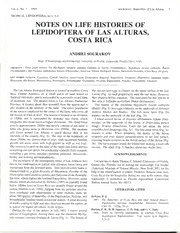
Notes on life histories of Lepidoptera of Las Alturas, Costa Rica PDF
Preview Notes on life histories of Lepidoptera of Las Alturas, Costa Rica
Vol. 6 No. 1 1995 SOURAKOV: Butterflies of Las Alturas TROPICAL LEPIDOPTERA, 6(1): 3-4 NOTES ON LIFE HISTORIES OF LEPIDOPTERA OF LAS ALTURAS, COSTA RICA ANDREI SOURAKOV Dept. of Entomology and Nematology, University of Florida, Gainesville, Florida 32611, USA ABSTRACT.- Food plant records for Mechanics menapis saturata Godman & Salvin (Nymphalidae), Hypothyris lycaste callispila (Bates) (Nymphalidae), and Oxytenis albilunulata Schaus (Oxytenidae), from Las Alturas Biological Station, Puntarenas Province, Costa Rica, are given. KEY WORDS: behavior, Catasticta, Central America, conservation, Dismorphia, dispersal, Euptychiini, hostplants, Hypothyris, immature stages, Ithomiinae, Mechanitis, Mesoamerica, Neotropical, Nymphalidae, Oxytenidae, Oxytenis, Papilionidae, Pieridae, Pronophilini, Satyrinae. The Las Alturas Biological Station is located in southern Costa this species lays eggs in clusters on the upper surface of the leaf. Rica, Central America, on a small patch of land leased to Larvae (Fig. la) feed gregariously until the last instar. However, Stanford University, and is surrounded by a privately owned farm they disperse before pupation. The food plant for this species in of enormous size. The nearest town to Las Alturas, Puntarenas this area is Solanum acerfolium Dunal (Solanaceae). Province, is located about 4km downhill from the station and is The female of the ithomiine Hypothyris lycaste callispila also located on the territory of the farm. The entire population (Bates) (Fig. 2) lays eggs solitarily on the underside of Solanum of the town is employed by the owner of the farm, who owns all brenesii Monter and Stadles. The last instar larva (Fig. 2a) the houses in town as well. The station is located at an elevation pupates on the underside of the leaf (Fig. 2b). of 1500m and is surrounded by montane rain forest, which I found several larvae of Oxytenis albilunulata Schaus (Oxy- integrades into cloud forest at higher elevations. The cloud forest tenidae) on the upperside of the leaves of Disforomita pittieri goes to approximately 2500m and mostly consists of oak trees; it (Engl.) D'Arey (Guttiferae). Until the last instar, the larva turns into grassy areas at elevations over 2500m. The montane resembles bird droppings (Fig. 3c). The last instar larva (Fig. 3a) rain forest around Las Alturas is much thicker than in the mimics a snake. When disturbed, the thorax of the larvae lowlands of the country (Fig. 5). The tops of the mountains, at contracts and rises almost perpendicularly to the leaf surface, about 2500m, are almost clear of trees, with occasional bamboo exposing bright eyespots on the dorsal surface of the thorax (Fig. growth and moist areas with high grasses as well as wet bogs. 3b). The larva pupates inside the folded leaf, making a loose silk The station is located on the edge of the virgin rain forest and has cocoon. The adult (Fig. 3) hatches about two weeks later. everything one can desire for conducting scientific field research, including a gas stove, gasoline-operating generator, microscope, ACKNOWLEDGMENTS books, and housing accommodations. The peculiarity of the lepidopteran fauna of Las Alaturas area I would like to thank Thomas C. Emmel (University of Florida, lies in the combination of typical mid-elevation forest fauna and Gainesville, Florida) for reviewing the manuscript; Cal Snyder immigrants from the lowland areas. This mid-elevation fauna is (American Museum of Natural History, New York, NY) for his characterized by a great diversity of Ithomiinae, Pieridae of the help in the identification of plants; Frederico Bolanus (San Jose, Dismorphia and Catasticta genera, and Satyrinae of the Pronophi- Costa Rica) for his hospitality during my stay at the station. This lini tribe, which replace the lowland Euptychiini. However, many manuscript is published as Florida Agricultural Experiment species which are indicated by DeVries (1987) as typically found Station Journal Series No. 04371. below 1000m level in Costa Rica are actually found around the station (Ehrlich et al., 1994). Judging from my personal observa- LITERATURE CITED tions combined with observations of other students, there are about 200 species of butterflies of the Papilionidae, Pieridae, and DeVries, P. J. Nymphalidae families found around the station. A great diversity 1987. The Butterflies of Costa Rica and their Natural History: of moths coming to light was also observed around the station, as Papilionidae, Pieridae, Nymphalidae. Princeton: Princeton Univ. Pr. 327pp, 50 pi.. is typical for higher elevations in the tropics. Ehrlich, P. R., H. R. Sparrow, T. D. Sisk, and G. C. Daily During my stay at the station in July 1992, I reared several 1994. Notes on butterfly distributions in southern Costa Rica species of Lepidoptera. Among them was the ithomiine Mecha- (Lepidoptera: Papilionoidea). Trap. Lepid. (Los Angeles), nitis menapis saturata Godman & Salvin (Fig. 1). The female of 5:21-23. PLATE 1. 1) Mechanitis menapis saturate', a) larvae feeding on Solatium acerfalium (Solanaceae) b) pupa. 2) Hypothyris lycaste callispila\) larva feeding on Solarium brenesii (Solanaceae); b) pupa. 3) Oxytenis albilunulata (Oxytenidae), a) last instar larva found on Disforomita piltieri (Guttiferae); b) front end of last instar larva: c) fourth instar larva. 4-5) Rain forest in the victinity of Las Alturas.
